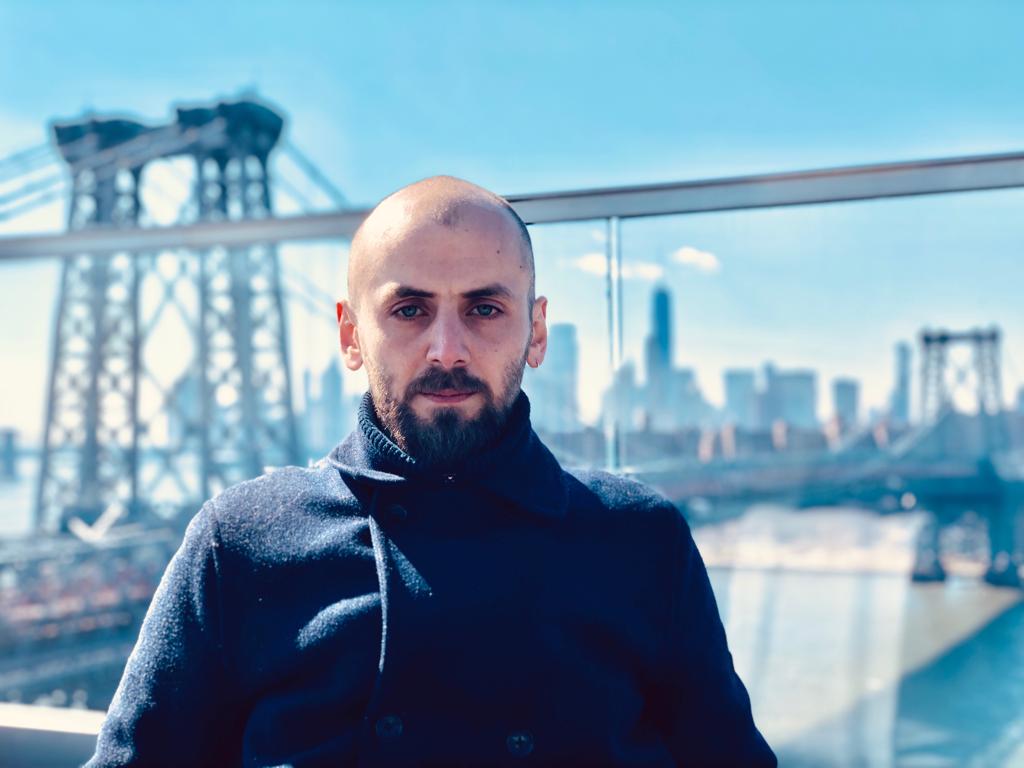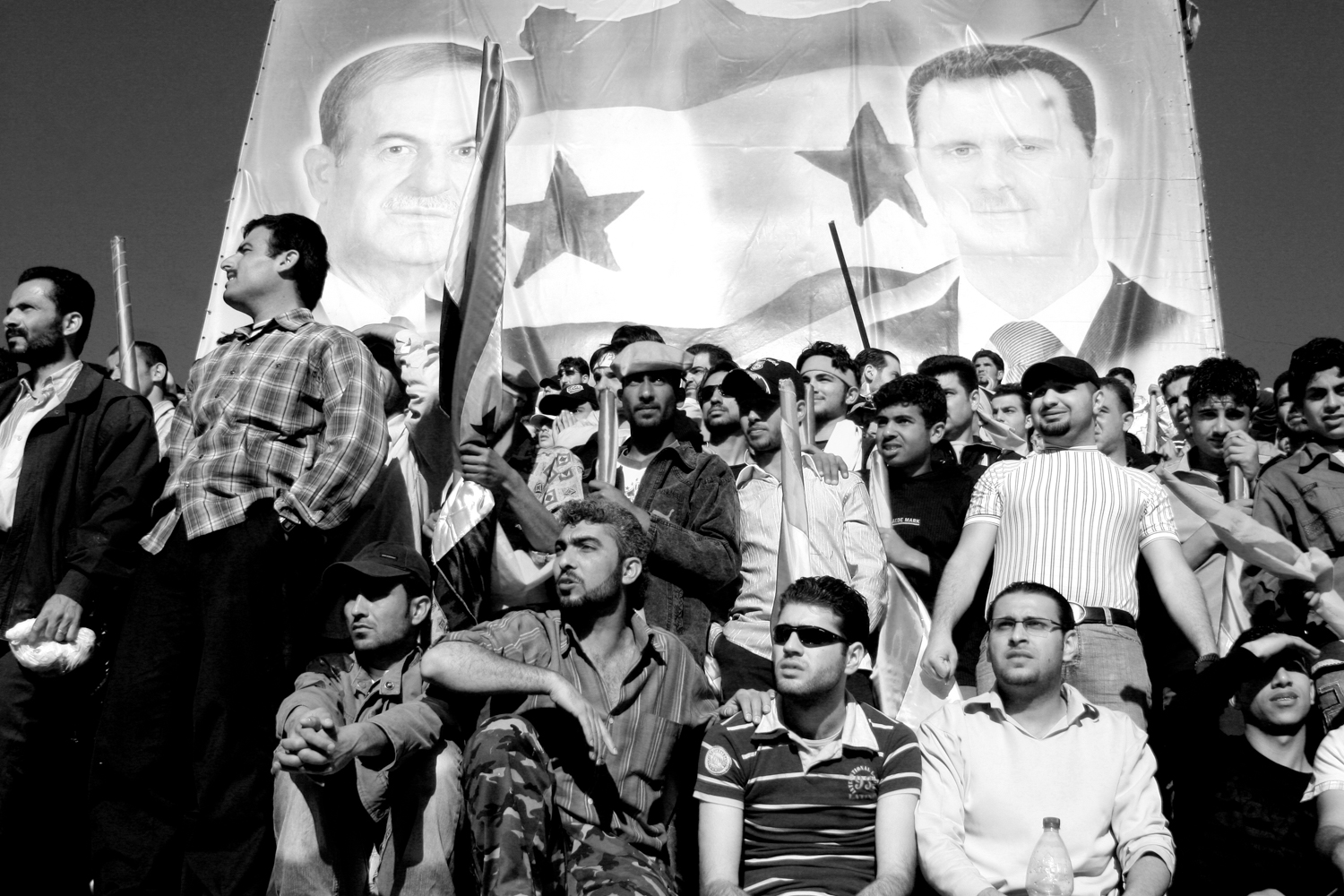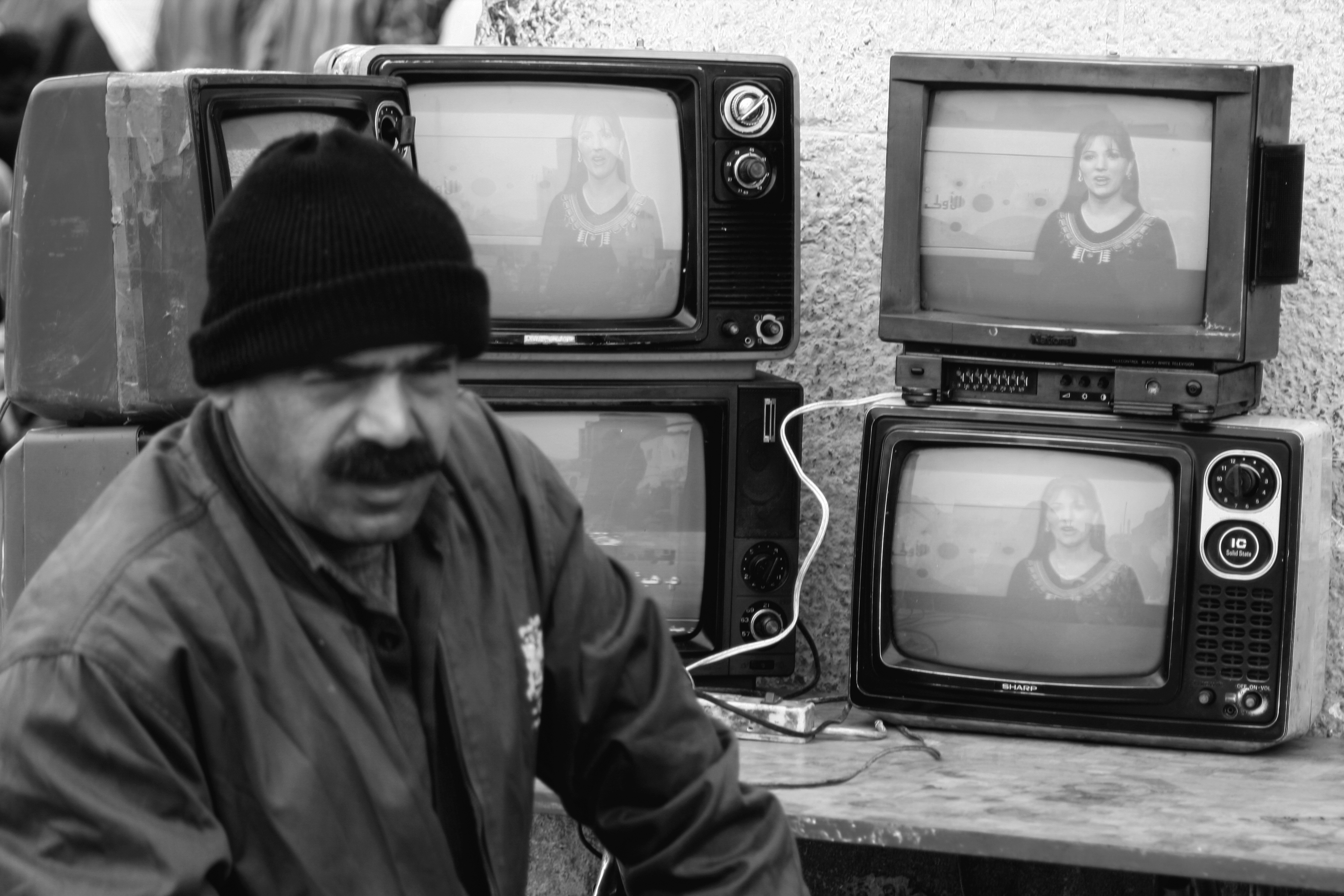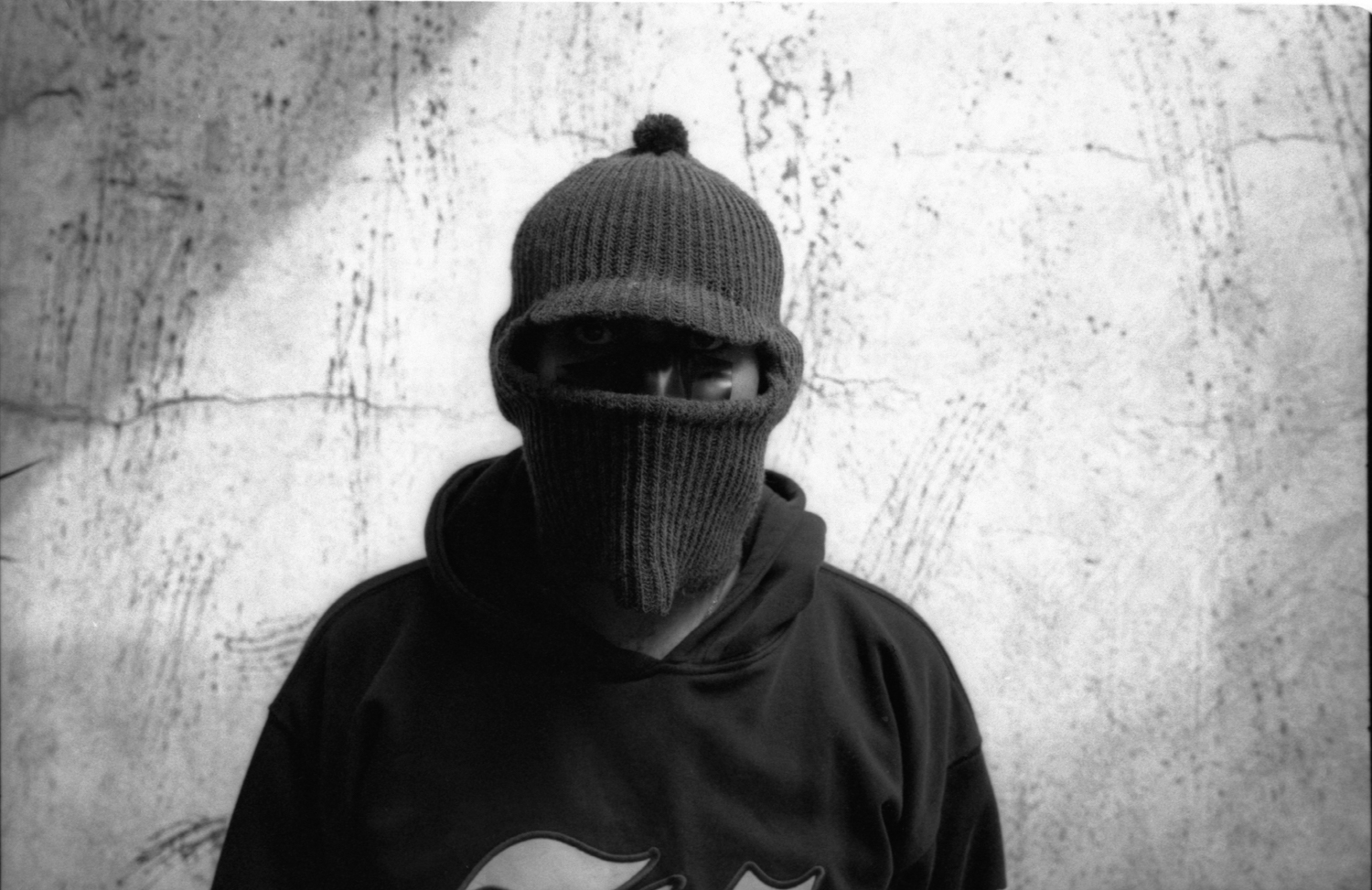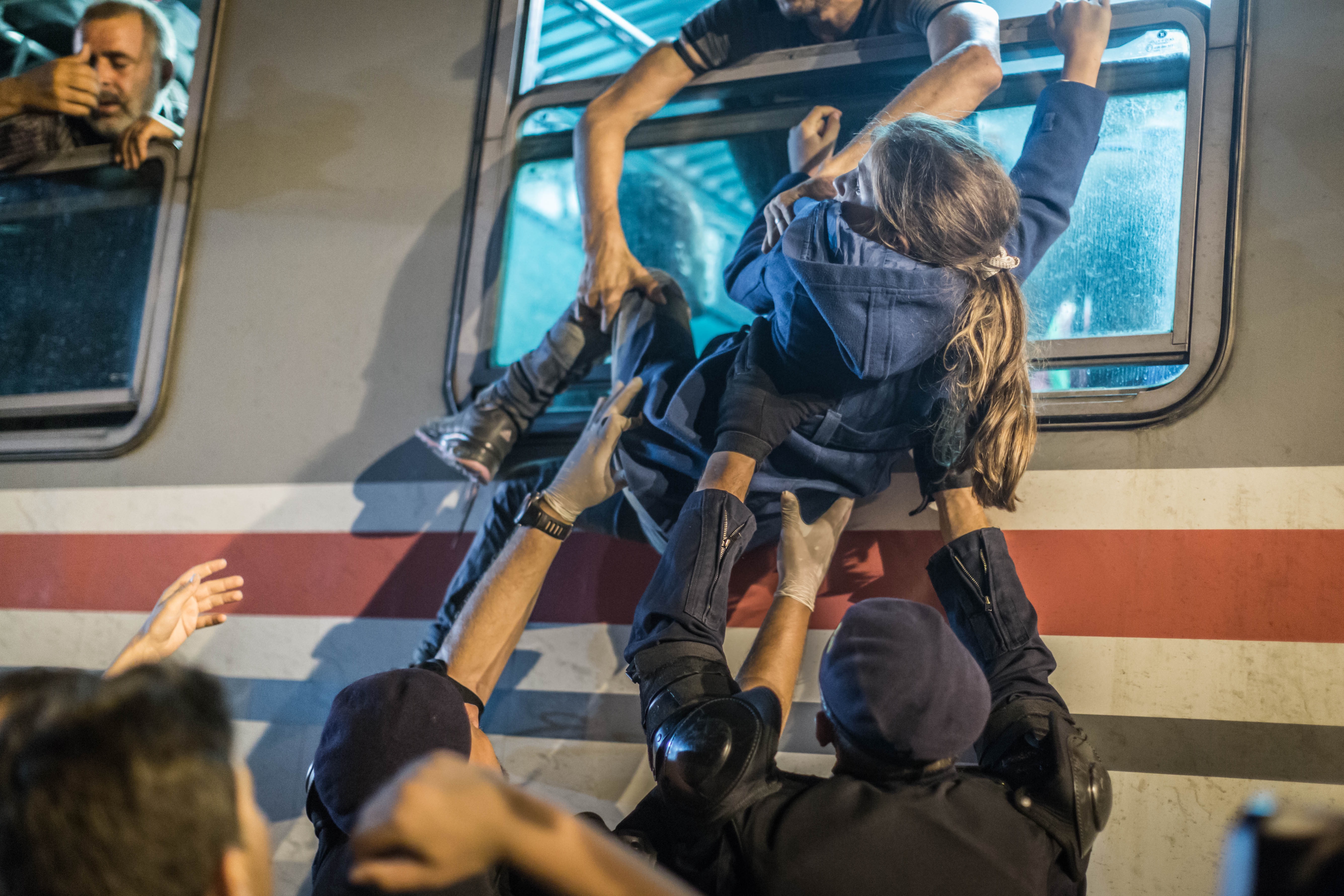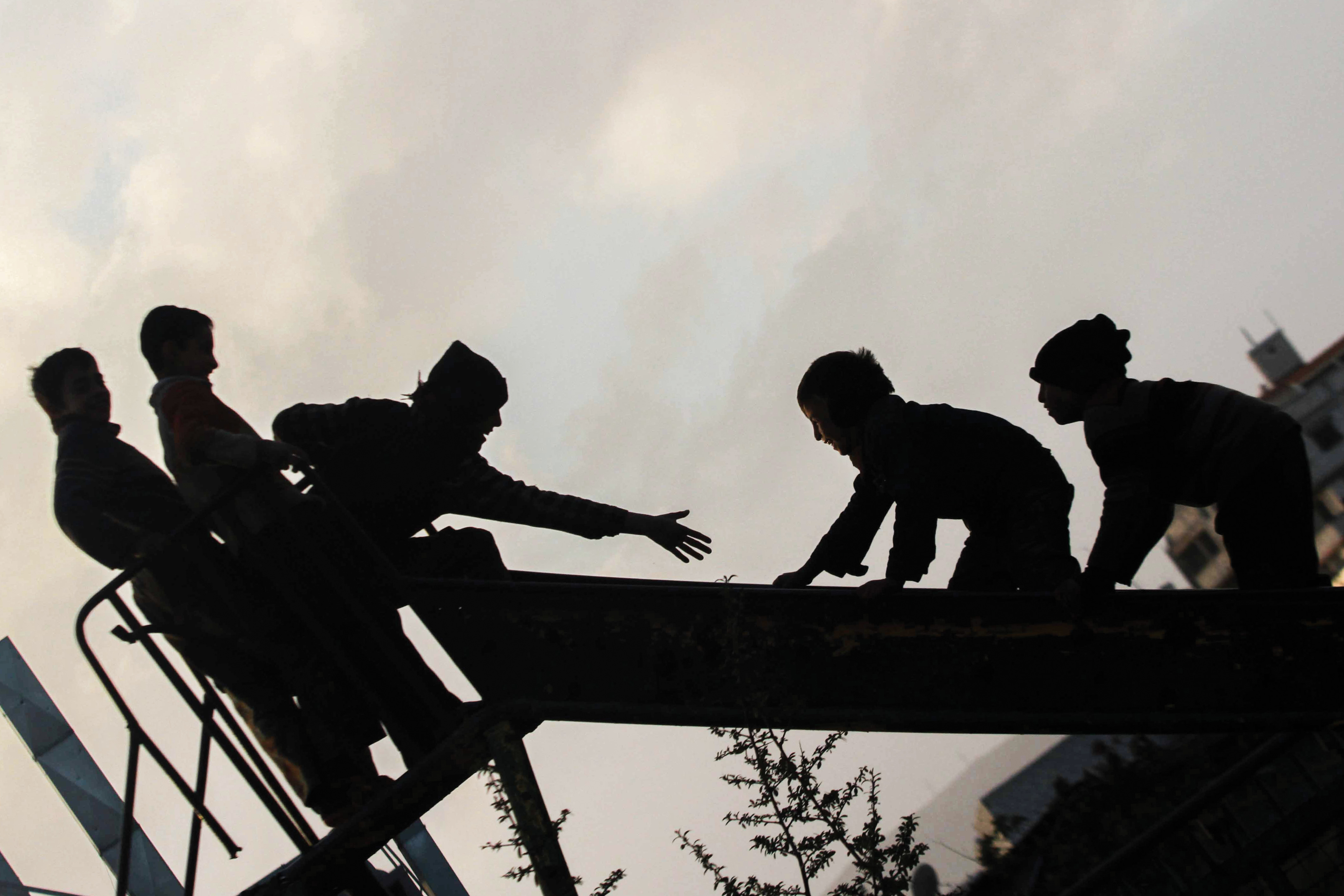This article is part of SyriaInFocus, a series on Syrian photography funded by the Friedrich Naumann Foundation for Freedom, with guest editor Sima Diab.
The regime holds power and influence over its narrative in Syria, one which all of us citizens must abide by and reproduce. This is the accepted version of Syria—that of an ancient nation and cradle of civilizations, whose simple and welcoming people love their leader, oppose imperialism in all its forms and support issues backed by the global Left, especially the Palestinian cause. This is the united Syria, where religions coexist and billboards show shrines embracing one another, in a hackneyed expression of unity and national identity.
At the center, the polished image of its savior leader everyone adores, and of a people who are unified living in all the places tourists would visit.
The regime, for its part, maintains this image through direct and indirect violence. Its security apparatus and cultural institutions play the roles of the censor and editorial authority. Those who have tried to cover political topics well before 2011 are aware of the near impossibility of that task.
In terms of photography, the country abides by a main rule: photos are forbidden until proven otherwise.The government carefully monopolizes and shapes the story of the country internally and externally. For that reason, independent media work simply didn’t exist. Besides, publishing in foreign media makes people vulnerable to being charged with “collaboration with foreign parties,” a serious offense, and no less absurd than the charge of “weakening the nationalist sentiment.” These charges are used to control the public discourse, and they constitute a deterrent force for anyone openly opposing the policies of the government or the nature of its rule.
The influence of this control does not begin and end with what is published or not published, but it encroaches on the very realm of the photographer and the purpose of photography itself. Average citizens and passers-by become temporary informants to preserve the regime’s image, and those who do not inform on a photographer attempting to steal a quick image become criminals. The Syrian photographers who wanted to document their realities, both good and bad, were too afraid to photograph and be photographed, and afraid to be seen and heard.
Naturally, street photographers could not publish any societal grievances in Syrian media outlets, or embody a Syrian identity separate from the regime’s propaganda. The photographers of the state-run news agency, SANA, did what their jobs in the government required, maintaining the pristine visual identity of the regime. Others either emigrated or refrained from publishing their photos, which were held captive in their archives or were displayed in purely aesthetic art exhibitions.
One of the main functions of photography as a visual medium documenting reality, especially that of groups left underrepresented or voiceless in the media, was overlooked. Even pictures with a political dimension were emptied of their content and displayed in galleries frequented by the cities’ affluents as a form of aesthetic art; showing the skill of the photographer or the beauty of the depicted material. Marginalization extends to the photo itself, whereby the poor person becomes one of its elements deprived of a voice, rather than the complex entity with a face and character. Contrary to the prevalent trends in photography around the world, Syrians are not accustomed to mobile photographers or street photographers as part of their daily lives.
Yet since photography’s very start, its technical purpose is to document reality. Its principles can be quickly learned and its skills can be developed through practice. As soon as cameras could be carried, photographers began using them to document reality and enhance communication between people. With the onset of the 20th century, the street photographer appeared and documented daily events, lifestyle and changes within a society. Their main goal was not to publish photos in the press to tell a news story, but to document reality, both individually and collectively.
The profession flourished in societies capable of protecting freedom of expression, and blossomed in environments that tolerated political differences. Images spread throughout media outlets based on credibility and their access to news. Although the photographer benefited financially from the short media cycle, like the daily newspaper which needs photos every day, the profession suffered under consumerism. After all, demand controls the artistic product, and the public requires more and more absurd and shocking images.
After decades of photography embracing magazines, gallery exhibitions, publishers and documentaries, then came the smartphone and internet and with it photographic democratization. A generation emerged where anyone could take a photo and publish it, reaching a wide audience without any editorial restrictions or censorship.
A generation armed with phones featuring cameras and connected to social media seized the opportunity and became a revolutionary soldier in the battle of traditional photos distributed by the press.
We often hear that the daily photos uploaded online amount to all the photos taken in the 20th century. Who will edit these photos? Who will verify their authenticity? Who will control their viewership? The answer is nobody and everybody.
People were not well-equipped for a time when photos went viral. As with everything, the technology was first introduced and then we began discovering its shortfalls with trial and error. Perhaps its biggest downside is the absence of an editor and the presence of algorithms. There was nobody to assess the value of a photo from an artistic, experience-based or even political perspective. The only thing that mattered was that it sold, based on the number of views and reactions. The attention economy has always banked on impressing people, because the number of reactions is the perfect measure for breeding profitability. It encourages quick consumption and readiness to consume more. If the internet wants us to publish photos of cats, no doubt we will provide the content!
Who is the narrator? Who is taking the platform and telling the collective story? Who are the protagonists? What are the key events? What are the causes? How do we understand what happened from our local perspective? We have lost so much, as individuals and as a people, but we have not lost our story yet.
This was the marketplace into which Syrian photographers innocently stumbled, just as the protesters took to the streets in 2011. Media attention focused on a country known for its methods of obfuscation, and the first weapon in battle was the camera. Taking photos became a necessary practice in the age of revolution, and instead of fearing the photographer, people often threw the phrase “God Protect You” at photographers in rebel areas.
The camera seemed to remove regional and class barriers, and Syrians were creating a new identity that carried as much urgency as it did impact. That was the image of the Syrian rebel, after 40 years of silence: anonymous without a name or face, with great attributes, an oppressed individual revolting against the regime.
Showing the Syrian rebel’s face, picture or video was not safe. The Syrian regime’s loss of control over wide areas of the state made matters worse, because photographers specifically, and media correspondents generally, were targeted by all the warring parties.
Publicity became a trap that might cost a person their life. Persecution of media figures became an expected part of the Syrian conflict, whether by assassination and arrest or through strict censorship on the output of “independent” or “alternative” media corporations.
After the first year, amid widespread counter-violence and dwindling peaceful protests, political propaganda in Syria deepened, and free media activity witnessed a setback. Young activists in the protests became photographers of battalions or for agencies. For the first time, dedicating one’s time to photojournalism became a real choice. The cycle of media coverage demanded an image of the Syrian war. But, this was not Syria’s real image. It was the image of of soldiers, destruction, terrorism, asylum and homelessness. Rarely was the Syrian citizen depicted outside these polarizing and political contexts.
The Syrian photographer was left with two options, just like any other photographer in any part of the world. Either use the camera to document and portray society, or use it as a weapon in a media war. In other words, either turn our cameras toward our points of interest and what we deem necessary or capture the photos expected by the editor, who lives in Beirut, New York, Moscow or Istanbul.
Since shocking images are profitable, and war is impressive, and since courage is an attribute of Syrian photographers, an unprecedented number of those photographers died in conditions that could have been avoided by training and planning. Neither the war nor the international wire agencies spared the local photographer.
The media industry, in its current model, has proven to be marred by a fundamental flaw. It is based, on one hand, on the tension between the desire and the need to relay the truth and document reality, and on the other, financial profit. Most of the large media outlets were drawn into the battle for attention and exclusive scoops at the expense of the truth. Many young people, fervently pursuing their message and cause, ended up paying the price for the production of the materials we consume on our screens.
The Syrian photojournalist, as a worker, has yet to obtain the most basic rights that European or American photographers enjoy. A Syrian journalist often does not have access to any physical protection, such as the protective vest, inscribed with the famous word “press,” and a helmet. Not to mention the lack of training in conflict zones and improper working conditions in terms of salary, health insurance and equipment. Most Syrian photographers worked as daily consultants, on a piece-by-piece basis, assuming responsibility for their own security, safety, transportation, equipment and food. They sold their photos to agencies, which in turn sold them at unfair margins to media outlets. Photographers had no control over the use or publication of the photos. The producer of the photo disclaims its content, context and place of usage. In journalistic practice, this is tantamount to complete waiver of rights under unjust exploitative colonial conditions.
This is not to say that the Syrian photographer is innocent in the media war; on the contrary, Syrians have mastered the art of lying to media outlets or at least using the media as a weapon in the battle. As a result, European, American and even Russian media outlets gained more credibility than any local outlet. The war in Syria changed the media coverage of armed conflicts in general and unraveled the complexity of the current relationship between the media and society.
This is also not to say that the situation in Syria isn’t as bad as it appears in the media. On the contrary, the tremendous devastation ravaging the country and the daily suffering of its inhabitants are the key features of the story.
And yet, despite the enormity of what has been happening, from a historical documentary angle, it remains critical to answer the following questions: Who is the narrator? Who is taking the platform and telling the collective story? Who are the protagonists? What are the key events? What are the causes? How do we understand what happened from our local perspective? We have lost so much, as individuals and as a people, but we have not lost our story yet. Perhaps this contradiction has an upside. With the loss of the story in the media war it underlines the need for it.
Perhaps we can tell our story and save face. We are not limited to the classifications of fighters, civilians, Islamists and others, supporters and opponents. These terms that override individualism and personal decision disappear as the media narratives change. Perhaps time is our ally in obtaining the appropriate vocabulary and the favorable environment for telling our story. So far, Syrians have the right to appear as individuals only when killed (martyred), mysteriously arrested (forcibly disappeared) or exiled with their families.
The Syrian individual must fight and sacrifice something dear for the sake of being recognized as their own person. This great individualism acquired through struggle could be the greatest, yet most unenviable, reward. Even if a Syrian gets such recognition safely, he still faces skepticism and stereotyping. Since media outlets do not tell our story, instead seeing it from their own political and commercial angles, and because we must lose everything before gaining integrity, perhaps the time has come for us to regain our integrity, for it is all that we have left after these ten years.


